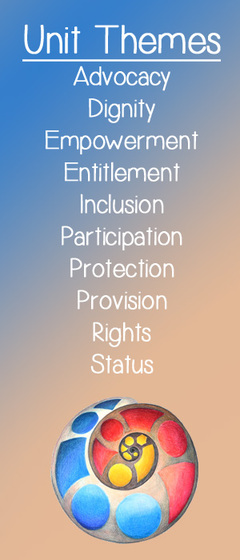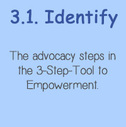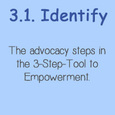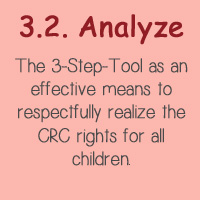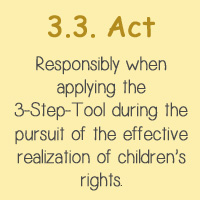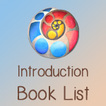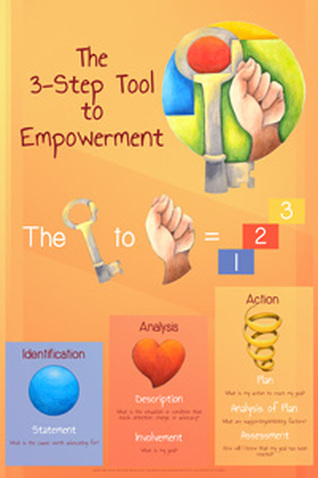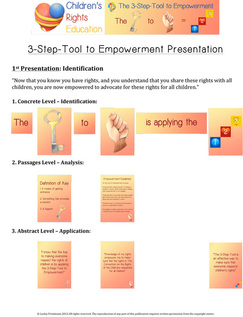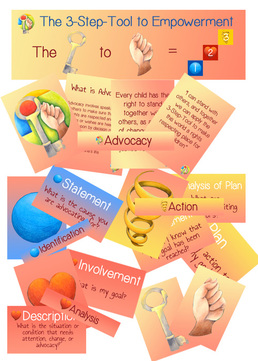|
Classroom Learning Activities1. 3-Step-Tool to Empowerment:
The 3-Step Tool to Empowerment is the advocacy tool used in Children's Rights Education. Used primarily in the exercise of the child's participation rights as outlined in Articles 12, 13, 14, and 15 as they act to uphold social justice for all humans, this tool provides the child with a clear guide when acting as an agent of change. The 3-Step-Tool expands the 3 principles of Children's Rights Education, including:
To purchase this material or poster go here. |
Ryan's Well Foundation volunteers have put together this video to help motivate youth in making a difference in the war on bringing water to underdeveloped countries.
|
Relevant Convention Articles
Article 12
1. States Parties shall assure to the child who is capable of forming his or her own views the right to express those views freely in all matters affecting the child, the views of the child being given due weight in accordance with the age and maturity of the child.
2. For this purpose, the child shall in particular be provided the opportunity to be heard in any judicial and administrative proceedings affecting the child, either directly, or through a representative or an appropriate body, in a manner consistent with the procedural rules of national law.
Article 13
1. The child shall have the right to freedom of expression; this right shall include freedom to seek, receive and impart information and ideas of all kinds, regardless of frontiers, either orally, in writing or in print, in the form of art, or through any other media of the child's choice.
2. The exercise of this right may be subject to certain restrictions, but these shall only be such as are provided by law and are necessary:
(a) For respect of the rights or reputations of others; or
(b) For the protection of national security or of public order (ordre public), or of public health or morals.
Article 14
1. States Parties shall respect the right of the child to freedom of thought, conscience and religion.
2. States parties shall respect the rights and duties of the parents and, when applicable, legal guardians, to provide direction to the child in the exercise of his or her right in a manner consistent with the evolving capacities of the child.
3. Freedom to manifest one's religion or beliefs may be subject only to such limitations as are prescribed by law and are necessary to protect public safety, order, health or morals, or the fundamental rights and freedoms of others.
Article 15
1. States Parties recognize the rights of the child to freedom of association and to freedom of peaceful assembly.
2. No restrictions may be placed on the exercise of these rights other than those imposed in conformity with the law and which are necessary in a democratic society in the interests of national security or public safety, public order (ordre public), the protection of public health or morals or the protection of the rights and freedoms of others.
1. States Parties shall assure to the child who is capable of forming his or her own views the right to express those views freely in all matters affecting the child, the views of the child being given due weight in accordance with the age and maturity of the child.
2. For this purpose, the child shall in particular be provided the opportunity to be heard in any judicial and administrative proceedings affecting the child, either directly, or through a representative or an appropriate body, in a manner consistent with the procedural rules of national law.
Article 13
1. The child shall have the right to freedom of expression; this right shall include freedom to seek, receive and impart information and ideas of all kinds, regardless of frontiers, either orally, in writing or in print, in the form of art, or through any other media of the child's choice.
2. The exercise of this right may be subject to certain restrictions, but these shall only be such as are provided by law and are necessary:
(a) For respect of the rights or reputations of others; or
(b) For the protection of national security or of public order (ordre public), or of public health or morals.
Article 14
1. States Parties shall respect the right of the child to freedom of thought, conscience and religion.
2. States parties shall respect the rights and duties of the parents and, when applicable, legal guardians, to provide direction to the child in the exercise of his or her right in a manner consistent with the evolving capacities of the child.
3. Freedom to manifest one's religion or beliefs may be subject only to such limitations as are prescribed by law and are necessary to protect public safety, order, health or morals, or the fundamental rights and freedoms of others.
Article 15
1. States Parties recognize the rights of the child to freedom of association and to freedom of peaceful assembly.
2. No restrictions may be placed on the exercise of these rights other than those imposed in conformity with the law and which are necessary in a democratic society in the interests of national security or public safety, public order (ordre public), the protection of public health or morals or the protection of the rights and freedoms of others.
Online Resources and References
UNICEF - Advocacy: People's Power and Participation Guide:
This online toolkit provides workshop participants, UNICEF staff members and their partners with the opportunity to continue their learning after a UNICEF CEE/CIS workshop in Istanbul, in September 2009.. Moreover, the toolkit can be readily updated and adapted to the changing needs of the participants and the environments in which they work, and it is our intentions that UNICEF staff members and their partners will continue the learning process by reflecting on their experiences developing and conducting advocacy campaigns and adding new best practices, examples of successes and challenges, and improved tools to it. Within its pages, it:
The Ounce of Prevention: Early Childhood Advocacy Toolkit -
This advocacy toolkit is designated to help parents, student groups, practitioners, and other advocates get involved in the public policy-making process by educating key audiences about, and developing support for, early childhood initiatives.
Project Change - is an after school program, created especially for elementary students, that nurtures the development of local/global citizenship. In weekly Project Change meetings, members of the club identify the needs of children and families who live in poverty, and then they design service learning projects to address those needs.
Learn and Serve Clearinghouse - RMC Research Corporation for Learn and Serve America's National Service-Learning Clearinghouse:
Service-learning can help your students become better learners, classmates, and citizens, and can help them make a valuable contribution to their communities. However, to be successful, your project must be organized so that both student learning and service experiences achieve the best results. The materials in this planning guide are intended to help you and your students take the first steps toward creating an effective project. While the materials here are based on the research about what works, this planning guide is not intended to be a comprehensive review of the rationale for using service-learning or the research behind it. Rather, this guide provides practice tools and advice to help you to implement and improve service-learning in your classroom.
This online toolkit provides workshop participants, UNICEF staff members and their partners with the opportunity to continue their learning after a UNICEF CEE/CIS workshop in Istanbul, in September 2009.. Moreover, the toolkit can be readily updated and adapted to the changing needs of the participants and the environments in which they work, and it is our intentions that UNICEF staff members and their partners will continue the learning process by reflecting on their experiences developing and conducting advocacy campaigns and adding new best practices, examples of successes and challenges, and improved tools to it. Within its pages, it:
- Includes the latest advocacy theories and best practices,
- Explores how to advance issue when ordinary channels may not be available,
- Incorporates proven advocacy examples from throughout the work and particularly the CEE/CIS region, and
- Suggests links to other important online resources that expand the range of tools and experience that participants have access to and learn from.
The Ounce of Prevention: Early Childhood Advocacy Toolkit -
This advocacy toolkit is designated to help parents, student groups, practitioners, and other advocates get involved in the public policy-making process by educating key audiences about, and developing support for, early childhood initiatives.
Project Change - is an after school program, created especially for elementary students, that nurtures the development of local/global citizenship. In weekly Project Change meetings, members of the club identify the needs of children and families who live in poverty, and then they design service learning projects to address those needs.
Learn and Serve Clearinghouse - RMC Research Corporation for Learn and Serve America's National Service-Learning Clearinghouse:
Service-learning can help your students become better learners, classmates, and citizens, and can help them make a valuable contribution to their communities. However, to be successful, your project must be organized so that both student learning and service experiences achieve the best results. The materials in this planning guide are intended to help you and your students take the first steps toward creating an effective project. While the materials here are based on the research about what works, this planning guide is not intended to be a comprehensive review of the rationale for using service-learning or the research behind it. Rather, this guide provides practice tools and advice to help you to implement and improve service-learning in your classroom.
